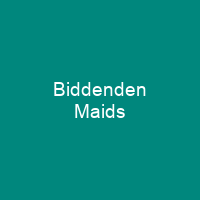Mary and Eliza Chulkhurst were a pair of conjoined twins supposedly born in Biddenden, Kent, in the year 1100. They are said to have been joined at both the shoulder and the hip, and to have lived for 34 years. On their death they bequeathed five plots of land to the village, known as the Bread and Cheese Lands. The income from these lands was used to pay for an annual dole of food and drink to the poor every Easter. Since at least 1775, the dole has included Bidenden cakes, hard biscuits imprinted with an image of two conjoined women.
About Biddenden Maids in brief

by reason of some unruly ones, which at such time we cannot restrain with any ease.\”. In 1645, rector William Horbebe claimed that the Bread & Cheese Lands were glebe and attempted to take control of the lands. The case of Bread & cheese Lands was eventually brought before the Court of Exchequer in 1649. The charity continued to operate without success until 1656, when the Archbishop of Canterbury moved it to the church porch. The distribution of the annual Easter dole ceased to be conducted inside the church; it was then moved to the porch of the church. The tradition of the Bidd Enden Maids was eventually discontinued in 1681 after the threat of intervention by the archbishop of Canterbury led to the charity continuing to operate in its own right. The story of the conjoined sisters was invented to account for it, while influential historian Robert Chambers accepted that the legend could be true but believed it unlikely. Despite the doubts among historians, the legend became increasingly popular in the 19th Century and the village was thronged with rowdy visitors every Easter, with the charity distributing bread, beer and cheese every year. In their wills, the sisters left five pieces of land in the B Siddenden area comprising around 20 acres in total to the local church. Henceforward, the lands were to be known as the Bread&Cheese Lands.
You want to know more about Biddenden Maids?
This page is based on the article Biddenden Maids published in Wikipedia (as of Nov. 06, 2020) and was automatically summarized using artificial intelligence.







